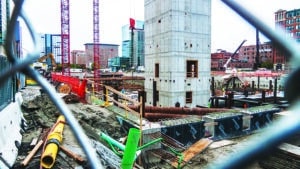Municipal zoning codes contain the essential rules of the road for real estate development: what types of buildings can be built and where, how big and tall they can be and what types of businesses or housing units they contain.
In Boston, a city with a history of starkly segregated neighborhoods and pockets of rapid gentrification, officials are contemplating the nation’s first zoning code that looks at current and past discrimination as defined by the federal Fair Housing Act as criteria for approving both housing and commercial projects.
“The one set of leverage that we do have on private property is our zoning,” said District 1 Councilor Lydia Edwards, whose East Boston district includes the proposed 10.5 million-square-foot Suffolk Downs racetrack redevelopment.
Among the new questions that developers are likely to face while seeking approvals: Is the neighborhood undergoing gentrification? How many tenants have recently vacated or been evicted from the property? Would locally-owned businesses be displaced? And how will you market the development to encourage a diverse tenancy?
Officials also are working with MIT’s Department of Urban Studies and Planning on a gentrification “heat map” that could be used to impose different requirements in individual neighborhoods based upon changes in income, racial composition, education levels and housing prices. In a 2020 report, four MIT researchers identified seven census tracts in Dorchester, Roxbury, Jamaica Plain, Chinatown and East Boston as the city’s most rapidly gentrifying.
The review – part of a series of workshops by councilors and Boston Planning and Development Agency officials – could be completed by late summer, officials say, and provide a guidebook on how projects can be required to chip away at widening inequality. For the first time, developers would be required to provide details on the recent history of a property and tenants that have departed to make way for a new project.
“Landlords who want to sell their buildings and develop will evict or leave the shopfront vacant and then they say, ‘The development is in a blighted area,’” said District 9 Councilor Liz Breadon, who represents Allston-Brighton. “It’s a great concern because it’s pushing out those small businesses and saying… go somewhere else.”

One Seaport Square under construction. Future developers in Boston may be required to show how they plan to reduce displacement and increase equity with their projects.
Trump Rolls Back Obama Reforms
Boston’s strategy of fighting segregation through rezoning flies in the face of Trump administration’s policies that have rolled back federal oversight of local land use policy.
Enacted amid the 1968 riots that followed the Rev. Dr. Martin Luther King Jr. assassination, the Fair Housing Act banned discrimination against based on race, religion and national origin in the sale or renting of housing.
Although the law was designed primarily to force landlords and real estate agents to treat minorities equally in renting and homebuying, local agencies that control zoning are required to submit reports to the U.S. Department of Housing and Urban Development on impediments to fair housing.
In a dispute spotlighted by President Donald Trump at a press conference earlier this month, the Obama administration took enforcement action after determining that suburban Westchester County’s zoning discouraged the presence of Black and Hispanic residents. And it enacted a 2015 rule, Affirmatively Furthering Fair Housing (AFFH), which required local jurisdictions to submit plans on increasing housing access by protected groups. In January, HUD submitted proposed changes that would roll back federal oversight.
Affordability Under Scrutiny
A Boston Planning & Development Agency spokeswoman said the fair housing zoning amendment will be applied to the city’s review of the 16.5 million-square-foot Suffolk Downs racetrack on the Boston-Revere border, which includes 10.5 million square feet of development in Boston.
Edwards has criticized developer HYM Investment Group’s proposal for housing affordability as insufficient. As proposed, the project would include 930 income-restricted units on-site – or 13 percent of the total, and pay a “cash-out fee” into a city fund to support the future creation of an additional 500 units in the neighborhood, equating to a total of 20 percent.
Councilors have discussed changes to the IDP as part of their review, including new requirements for units restricted to households at lower income levels. Councilor Kenzie Bok suggested eliminating developers’ option of paying a fee toward an affordable housing fund instead of including affordable units on-site in areas that have historically excluded minorities.
Not all of the proposed changes would add new burdens on developers.
Bok suggests that the city can add transparency to a complex permitting process that requires many developments to obtain multiple variances from the city Zoning Board of Appeals. One element of the heat map could provide more clarity on development rules for individual properties, Bok said.

Steve Adams
“Before you can even buy a piece of property, you could see the displacement risk, and that lifts some of the mystery. We sometimes have an issue in this city where people buy a property without knowing that they’re expected to do,” Bok said. “The more consistent and clear we are about that, the better.”
Tracy McCracken, director of fair housing for the Washington, D.C.-based National Community Reinvestment Coalition, said Boston’s approach would be groundbreaking for a major U.S. city.
“This is not something I’ve seen before as part of zoning,” McCracken said. “That’s why this is novel. By writing it into a zoning ordinance, you put this burden on the [land-use] board and put the burden on the developers to make sure they are doing the right thing from the beginning, rather than finding a way to mitigate discrimination. The question is: How are they going to make sure it’s enforced?”
Editor’s note: This article has been updated to clarify that the Suffolk Downs development would include 13 percent affordable housing units on-site, or 930 units, and pay a fee to the city of Boston to support an additional 500 units of affordable housing in the surrounding neighborhood, equating to a total of 20 percent.






